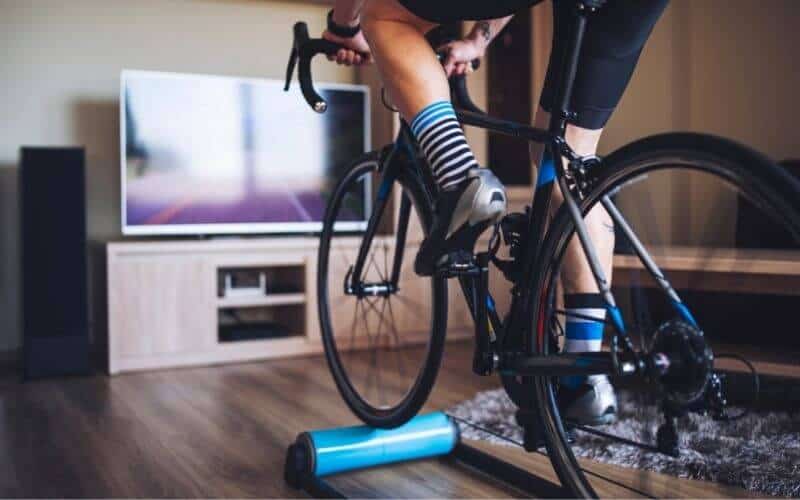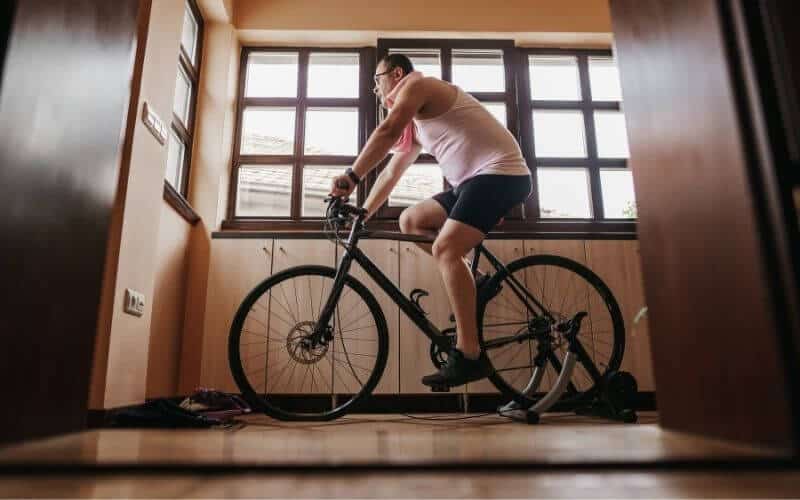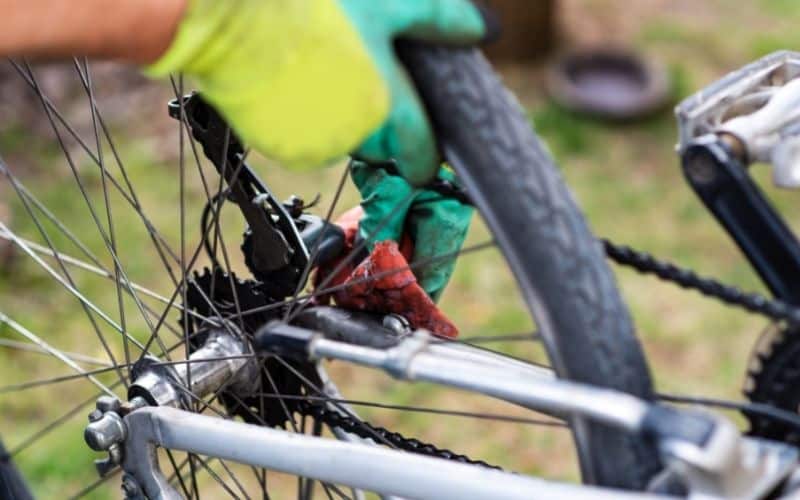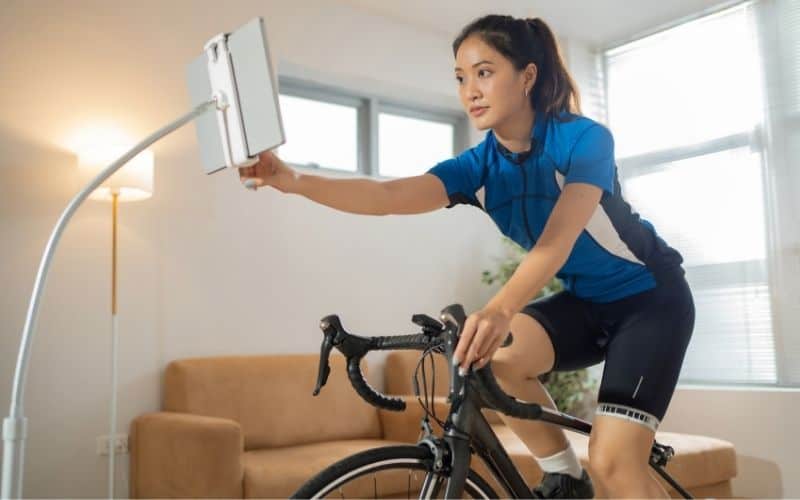When winter is closing in, you don’t want to lose your training progress so, if you’re like me, you could be considering a set of rollers. There are a few things to think about and my main question was…
Do rollers damage your bike tires? Rollers won’t damage your bike tires or cause them to wear out the same way a bike trainer does. Whilst both tires will be in contact with the rollers, the rollers are smooth and don’t put a lot of pressure on the tires.
Rollers don’t keep your bike tires totally free of wear and there are a few other considerations to think about so let’s do this!
Do Rollers Ruin My Bike Tires?
If you’re looking for a way to replicate riding outdoors, inside, then rollers are a great option.
They require you to balance as you’re pedaling and this forces you to ride in the same way you do when out on the road.
As rollers are so good at replicating road use, it does beg the question as to how much they wear the tires and potentially even damage them.
I bring you good news!
Rollers are one of the best indoor cycling training tools for minimizing wear on your bike tires and your bike generally.
A bike trainer uses your rear tire to drive the motor so it will wear out your tire more quickly than even cycling on the road.
Often you can see evidence of this on the floor behind the trainer. It can happen quickly too! After a few sessions (or one hard session), you are likely to see specks of your tire that have flaked off during use.
None of this happens with rollers. This is due to the fact that rollers don’t require your tire to engage with a motor. The surface is flat and smooth, therefore the pressure on the tires is minimal.
So yes, you are going to see some wear but rollers shouldn’t ruin your bike tires.
Related article – 5 Of The Best Floor Mats For Indoor Cycling

Do I Need Special Tires For My Rollers?
Training indoors can be great, though one of the not-so-great things is the wear on your tires it can cause through constant friction and the output of heat coming from the trainer.
You will find that a lot of cyclists recommend that you use a tire specifically designed for indoor trainers.
Why?
The tread is lower and the texture is smoother so this reduces the amount of friction.
Another thing some people do is use an old bike tire on their trainers. It saves money so it can be a good option if you have an old tire around!
When you’re using rollers, it’s a different ball game and you may not need specific tires for training.
Having said that, if you want to use an old set of tires, you can. It does have the advantage that it will give you a quieter and smoother roll so there is something to be said for it.
If you have your heart set on using special tires for your rollers, there are some available. Personally, I don’t feel they’re needed but it’s up to you.
A cheeky tip for you…if you choose to use old tires, always ensure that they’re clean. You should remove the dirt lodged between the treads as this will increase the wear on your rollers.
Related article – How To Prevent Your Indoor Trainer From Damaging Your Bike

Tips For Preventing Damage To Your Tires
Instead of paying for a special tire, why not try some of these tips and tricks first!
Pedalling Technique
Some of this is going to come down to how you ride on the rollers. You want a good, smooth-pedaling technique – this also helps you get the most out of your session!
When you aren’t pedaling in a smooth manner, and your pedal strokes are on the choppy side, it can become difficult to balance on rollers. When it becomes difficult to balance, it can cause uneven tire wear.
The huge upside to this is that you’ll soon learn the best and most efficient way of applying power to your pedals!
Keep It Clean
Ensure that your tires are clean and free from road debris. Any grit can impact the smoothness of the rollers and this can potentially lead to damaging your tires.
Tire Pressure
Tire pressure is always key wherever you’re riding and with rollers, it’s no different.
Too low and you’re unlikely to be able to balance correctly, or efficiently. This can lead to uneven tire wear. Lowering your tire pressure is a good way to increase resistance but strike a fine balance.
Related article – When Should I Replace My Bike Rims?

Roller vs Trainer
It’s a debate I’ve been having – which is better?
Rollers have more of a stripped-back approach in many ways unless you go for a smart roller set-up, of course, then you’re getting all bells and whistles – which is very fancy!
However, with the basic rollers, it can be more difficult to link to apps such as Zwift and even upload your effort to Strava (data nerd speaking here).
Related article – How To Record Indoor Cycling With Strava
Saying that rollers do have the benefit that you must concentrate, you have to apply your brain or frankly, you’re going to come off.
Why is that good, you may be wondering…it means that time does pass more quickly. It also means that you are focusing on your form and that can be hugely beneficial to your fitness progress overall.
Let’s say you find reaching for something in your jersey pocket while riding a challenge, or holding a line, spending some time on rollers can help you improve this. Rollers are superb for improving your balance and bike handling skills and well, yeah, that’s something I could benefit from!
They most certainly have unique benefits!
I couldn’t possibly forget that rollers won’t damage your bike tire, wheel-drive trainers are hard on tires, so hard that you should use a special tire.
Anyway, here are the key pros and cons of each!
Pros And Cons Of Rollers
Pros
- No need to swap tires for a training tire or remove wheels – just hop right on
- Encourages you to maintain a good pedaling technique
- Your core needs to be engaged so you train your full body
- Mimics the road feel with a smooth feeling
- Some rollers can be folded and are lighter than trainers so they are quite portable. Ideal if you need to warm up for a race!
Cons
- Going to take some getting used to, which can slow your progress down to start with
- Limited resistance except on the expensive models
- Few connect with apps that use ANT+ and Bluetooth
- You need to concentrate throughout the whole session (this does mean that time usually passes more quickly though!)
- Getting out of the saddle is an art you’ll need to master over time
Related article – Best Portable Bike Trainer: Complete Buying Guide
Feeling daunted by the prospect of getting used to rollers? Here’s a guide!
Pros And Cons Of Smart Turbo Trainers
Without question, turbo trainers are becoming the more popular choice so let’s see what’s so great/not so great about them!
Pros
- Power data is available, so you don’t have to have a power meter. For those who like data, this can be a huge deciding factor
- You can pair them with different apps such as Zwift, Fulgaz, etc
- Resistance is adjustable to give you a more varied workout
- Able to give it your all – sometimes harder efforts than that on the road
Cons
- You don’t need to engage your upper body or core (you can do so consciously!), so you aren’t getting a full body workout
- Non-direct drive trainers can feel a bit ‘draggy’
- Direct-drive trainers can be pricey
- Wear on your tires for non-direct drive ones can be sizable
Don’t have a smart turbo trainer and want to use Zwift? No problem – we answer that very question here!

Frequently Asked Questions
Are rollers quieter than turbo trainers?
Bike rollers used to be very noisy and that limited where you could use them. Nobody wants to be that neighbor after all.
Things have changed and there are now plenty of ‘silent’ rollers out there. I’m looking at you, Saris CycleOps Roller 😉 so there aren’t any reasons to rule rollers out these days.
In fact, rollers can be quieter than turbo trainers!
How do you increase resistance on bike rollers?
If you’re looking for simple ways to add resistance then let some air out of your tires, it makes them sluggish and you’re going to have to work harder – simple!
Another way some cyclists add resistance is by folding a towel and putting it under the rear drum – just choose an old towel!
If you want to get yourself some serious kit, you can opt for a fancy smart roller, something like the Elite Nero Smart.
It comes with full compatibility with all of your favorite apps, such as Zwift, and the ability to add resistance.
Final Thoughts
Hopefully, I’ve satisfied your worries about rollers and the impact they have on bike tires…which is minimal thankfully!
If you’re looking for your ideal winter/indoor training companion, a set of rollers could be for you. They encourage you to maintain good form and help improve your bike handling skills.
Aside from the fact we have to get used to balancing on rollers, there is a whole load of positives for them!
#TeamRollers
You may also be interested in How To Track Indoor Cycling

